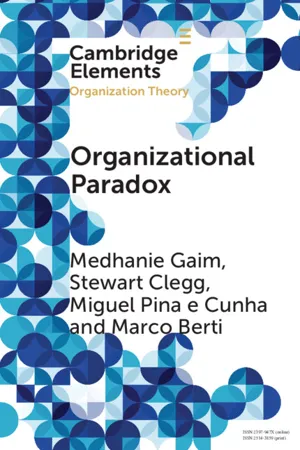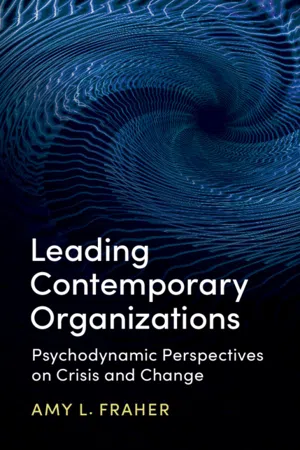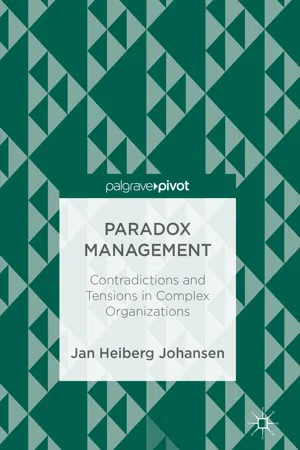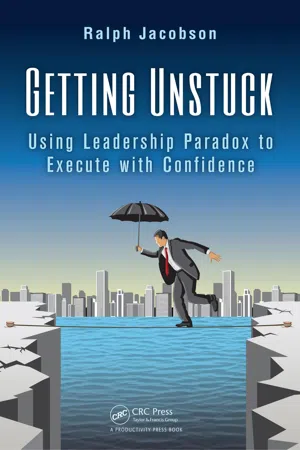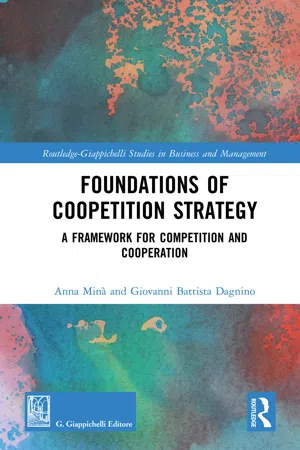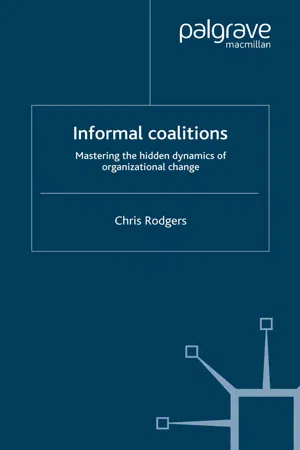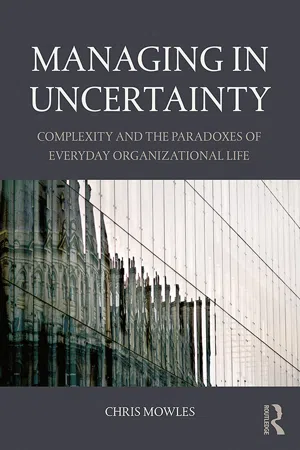Business
Paradox Theory
The Paradox Theory in business refers to the idea that contradictory elements can coexist and even complement each other. It suggests that successful businesses are able to navigate and leverage opposing forces, such as stability and change, efficiency and innovation, or short-term and long-term goals. Embracing these paradoxes can lead to greater adaptability and competitive advantage in the business world.
Written by Perlego with AI-assistance
Related key terms
1 of 5
7 Key excerpts on "Paradox Theory"
- eBook - PDF
- Medhanie Gaim, Stewart Clegg, Miguel Pina e Cunha, Marco Berti(Authors)
- 2022(Publication Date)
- Cambridge University Press(Publisher)
It is important to note, however, that managing tensions and hybridizing organizations is complex and dynamic, which means the art of managing paradox is a work in progress, never fully achieved, rather than a state that can be obtained on a permanent basis. In this Element, we explore organizational Paradox Theory. We present paradox as a meta-theoretical perspective (Lewis and Smith, 2014) for theoriz- ing and as a lens to analyse the nature and implication of tensions in organiza- tions. As a meta-theoretical perspective, paradox (compared with the contingency perspective) can be deployed as a primary or a secondary theoret- ical lens in MOS, helping to make sense of managing and organizing as an exercise of articulating contradictions at multiple levels of analyses. From a paradoxical perspective, paradoxes exist at the level of individuals, such as in sustainability-related identities (Kiefhaber et al., 2020) or creative individual approaches to work (Miron-Spektor et al., 2011b); in dyads, namely leadership duos (Raffaelli et al. 2021); in teams (Silva et al., 2013); in the logics underpin- ning organization (Ashforth and Reingen, 2014) and in inter-organizational systems such as value chains (Brix-Asala et al., 2018; Schrage and Rasche, 2021). Paradox can be used to complement other approaches (e.g., contingency approach) of organization featuring the potential presence of synergy but also trade-off (Li, 2016). With such goals in mind, the Element is structured into four main sections. Section 3 introduces the reader to the notion of paradox in theory and practice. We explore what paradox is and what it is not. We distinguish paradox and other close conceptualizations such as trade-off, dilemma, dialectics and ambiguity. 6 Organization Theory To give the reader a foundation, we discuss the main ontological and epistemo- logical assumptions in paradox theorizing. We cover paradoxical roots and traditions from the East, the West and beyond. - eBook - PDF
Leading Contemporary Organizations
Psychodynamic Perspectives on Crisis and Change
- Amy L. Fraher(Author)
- 2020(Publication Date)
- Cambridge University Press(Publisher)
In this chapter, I begin by adding another element to the psychodynamic kaleidoscope: organizational paradox. A paradox, in the usual sense of the word, is a phenomenon containing simultaneous truths or opposing facts that are juxtaposed in a manner that causes confusion. For example, neither of the following statements is problematic until the sentences are con- sidered together: “The following sentence is false. The preceding sen- tence is true.” 1 Or consider Charles Dickens’ famous opening sentence in A Tale of Two Cities: “It was the best of times, it was the worst of times”; Oscar Wilde’s comment: “I can resist anything but temptation”; or George Bernard Shaw’s observation: “What a pity that youth must be wasted on the young.” These famous quotes illustrate the dualistic nature of a paradox. More recently, Paradox Theory has been applied in a range of research areas such as the study of management teams, innovation, strategy, and CEOs. 2 Cincinnati Professor Marianne Lewis observes that contempor- ary organizations and their focus on global marketplaces, technological developments, and workplace diversity create a range of embedded organizational paradoxes for employees to sort through. 3 For example, leaders today are expected to improve efficiency yet also foster innov- ation, enhance profitability yet also act ethically, develop teams yet also reward and retain individuals, and think globally yet act locally. These paradoxical organization challenges have attracted the attention of man- agement researchers, with a recent study identifying more than 850 pub- lications about Paradox Theory in a literature review. 4 However, few academics have linked paradox and crisis in the study of contemporary organizations, which I believe is a glaring oversight. As an organizational concept, academic scholars define paradox as contradictory yet interrelated elements that exist simultaneously within organizations and persist over time with no clear path toward resolution. - eBook - ePub
Paradox Management
Contradictions and Tensions in Complex Organizations
- Jan Heiberg Johansen(Author)
- 2018(Publication Date)
- Palgrave Pivot(Publisher)
2003 ). Thus, organizational actors should strive to make sense of paradoxical tensions rather than hide them away.Chapter Summary: Paradoxes Unite Theory Positions
Paradox Theory embraces such diverse positions as functional theory, critical theory, structuration , Taoist theory, and psychotherapeutic theory. It can nuance the understanding of organizations to bring different perspectives in use within the same overall optic. In this way, paradox management can contribute to more well-rounded images of the challenging organizational reality.In the introduction, skeptical and optimistic views of paradox management were touched upon. The skeptical view reduces the paradox concept to yet another buzzword in management. Paradox management shows the way to hell by defining impossible demands as a condition for organizations. Paradox thinking can be criticized as a paradoxism , that is, an excessive use of juxtapositions without relation to the perceived reality. The optimistic view considers paradox management as an inclusive meta-theory that can help create competitive organizations by integrating and transcending organizational paradoxes.The story of how paradox management has evolved within organizational theory presents a more nuanced reality. Both skeptical and optimistic approaches to Paradox Theory overlook important points. The skeptical view overlooks the evidence that organizational actors experience paradoxical tensions and the fact that Paradox Theory is used in a wide range of theoretical perspectives on management. The literature includes evidence of organizational paradoxes through thorough empirical studies, and it includes critical optics of organizations focusing on how to unmask misuse of power. The optimistic view ignores that it is important to specify the scope of the paradox concept to establish a foundation for - eBook - PDF
Getting Unstuck
Using Leadership Paradox to Execute with Confidence
- Ralph Jacobson(Author)
- 2013(Publication Date)
- Productivity Press(Publisher)
Few leaders use the concept of paradox to shape their strategic plans. The author interviewed twelve leaders, some from Fortune 500 companies, and learned that only two of them knew what the word paradox meant and used Organization Paradoxes: Understanding Resistance to Change • 17 the concept of paradox actively to lead their organizations. The others have lost a key rudder for navigating through uncertainty and difficult times. Example: Using Paradox for Strategic Advantage THE CONTEXT Robert W. Baird is an employee-owned wealth management, capital markets, asset management, and private equity firm. Like almost all other financial firms, Baird suffered significant losses during the economic decline of 2008 and 2009. During that time the future for all financial services companies appeared bleak and the path to the future unclear. THE DRAMATIC CONFLICT Baird’s CEO, Paul Purcell, looked at the situation from a different perspec-tive. While other financial services organizations laid off some of their most experienced and capable people because they could no longer afford to pay them, Purcell saw a once in a lifetime opportunity to garner talent that would normally not be interested in working for his organization. THE RESOLUTION Purcell framed the paradox with two questions: • How do we reduce expenses to survive the current downturn AND • How can we take advantage of current circumstances and hire some of the best people in the industry so that we will thrive in the future? The Baird employees were confused when the two questions were raised simultaneously. They had never heard of a company facing significant financial challenges hiring people. Managing the paradox required constant and tar-geted messaging from Purcell. “In the morning I would demand that we look for places to cut expenses—nothing was too small to be examined. - eBook - ePub
Foundations of Coopetition Strategy
A Framework for Competition and Cooperation
- Anna Minà, Giovanni Battista Dagnino(Authors)
- 2021(Publication Date)
- Routledge(Publisher)
et al., 2019, p. 108).Overall, “since paradoxes are persistent, the tensions are never fully resolved, but only managed through mechanisms that recognize their persistence” (Keller & Sadler-Smith, 2019, p. 165). Consequently, firms should acknowledge what are the opposites they have to deal with (e.g., rational planning vs. emergent planning, commitment vs. flexibility, mass market vs. niche market), rather simply than choosing between them (Handy, 1994; Pinto, 2019), and understand that to respond to such opposite demands implies ongoing responses (Keller & Sadler-Smith, 2019; Pinto, 2019; Smith & Tracey, 2016).As we can see, for this reason “the paradox literature has become increasingly crowded” (Smith & Lewis, 2011, p. 381). We have seen progressions in understanding paradox, to theorize and enrich the current debate on paradox and paradoxical tensions (De Keyser, Guiette & Vandenbempt, 2021). Scholars acknowledge that paradoxical reasoning is useful in supporting future strategic contexts as it challenges the dominant logics. As Poole and Van de Ven (1989, p. 563) underscored, “there is a tendency for the theory to dominate researchers’ thinking and “bind the researcher’s judgment”. Accordingly, researchers tend to iron out problems, set the measures, test the theory and defend them. Then, they progressively become unable to consider aspects that were not previously included in their theorizing, and hence ignoring the “less and less correspondence to the multifaceted reality of strategizing itself” (Rasche, 2008, p. 182).Considering the role of paradox in strategic management would allow to dig deeper into the current understanding of strategic reality (Lewis & Kelemen, 2002), and rethink about what is taken-for-granted (Lado, Boyd, Wright & Kroll, 2006, p. 118).Second, it allows to critically think about paradox. Paradox could not be conceived as something that is impossible to occur. As Czarniawska (2005) pointed out, while non- paradoxical theories look more elegant a precise, they tend to ignore how complex is the management realm. Man-agement realm is paradoxical. Then, scholars should embed paradoxes in elaborating their strategy theories. - eBook - PDF
Informal Coalitions
Mastering the Hidden Dynamics of Organizational Change
- C. Rodgers(Author)
- 2006(Publication Date)
- Palgrave Macmillan(Publisher)
First, such a view draws on the positive aspects of contending ideas, perspectives and values (such as “non-team” working, in Morgan’s example above). Secondly, it acknowledges the potentially negative aspects of what are otherwise well-intended policy shifts and seemingly common-sense actions. Embracing paradox in this way needs to become a fundamental component of organizational leadership. Otherwise, leaders’ normal patterns of perception, language and behavior will hold sway, and they will remain oblivious to paradox’s existence, impact and potential power. This element of the developing leadership agenda seeks to raise awareness of this role and to offer practical tools for engaging with it. The nature of paradox in organizations When viewing leadership and organizational dynamics from an informal coalitions perspective it is important to recognize that organizational life – and life in general – is paradoxical. The essential elements of a paradox are the simultaneous presence of conditions that are self-contradictory and apparently mutually exclusive. In this Chapter, we will look at three of the most important ways in which paradox affects the dynamics of organizations. These are: Embracing paradox 197 1 The Leadership Paradox, in which leaders are both “in control” of their organizations and “not in control” of them at the same time. 2 The Performance Paradoxes, which refer to the strategic tensions that must be managed continuously and dynamically, if organizations are to perform effectively in the here and now and, at the same time, to sustain and develop their performance into the future. 3 Organizational Paradoxes, which relate to the everyday tensions and contradictions that characterize life in all organizations. These also need to be managed dynamically rather than being thought of as prob- lems to be solved in a once-and-for-all way. - eBook - ePub
Managing in Uncertainty
Complexity and the paradoxes of everyday organizational life
- Chris Mowles(Author)
- 2015(Publication Date)
- Routledge(Publisher)
By taking a radically social view of mind, that it arises inter- and intra-subjectively, I am not assuming that we form individual mental representations of a world ‘out there’, but have argued instead that consciousness and self-consciousness arise through processes of mutual recognition. These social processes create unconscious drives which we are barely aware of, thus making it highly problematic to suggest that we can knowingly surface the way we make sense of the world and consciously change it.Paradox as a dynamic equilibriumLastly, in this section I treat an article recently published in a leading management journal, the Academy of Management Review. The reason for doing so is because both scholars have made a reputation for themselves in writing about paradox, and I think as an example it helps us understand what is valued in management research and the kinds of assumptions it is based on, in particular that paradox can be instrumentalized by managers to unleash creativity and positivity, ideas which we previously encountered in the psychology literature.In a wide-ranging article, Smith and Lewis (2011) try to synthesize 360 journal articles about paradox across 12 academic journals in order to increase conceptual clarity. They do so, they argue, in order to integrate the differing conceptions of paradox into an overall model to further organizational theorizing. Their aim is to ‘leverage the potential’ of different conceptions of paradox by developing a dynamic equilibrium model, understood in terms of biology, or systems dynamics, where opposing forces are maintained in terms of a fluctuating homeostasis.They set out their own understanding of paradox as being the property of a system: ‘First, paradox denotes elements, or dualities, that are oppositional to one another yet are also synergistic and interrelated within a larger system’ (2011: 386). The paradox turns on the interrelationship of the duality across an internal boundary and defined by an external boundary, which binds the paradox and allows it to persist over time. The authors make a distinction between paradox and dilemma, and paradox and dialectic.
Index pages curate the most relevant extracts from our library of academic textbooks. They’ve been created using an in-house natural language model (NLM), each adding context and meaning to key research topics.
